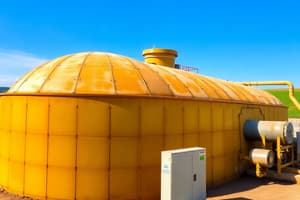Podcast
Questions and Answers
What is the primary purpose of a covered lagoon biodigester?
What is the primary purpose of a covered lagoon biodigester?
- To reduce the volume of solid waste
- To ferment diluted manure and produce biogas (correct)
- To store excess water from a farm
- To enhance the growth of crops
What is one of the common problems faced by covered lagoon biodigesters?
What is one of the common problems faced by covered lagoon biodigesters?
- Excessive water accumulation
- Insufficient biogas generation
- Whaling due to geomembrane leakage (correct)
- Clogging of the influent system
What factor does the volume of a biodigester depend on?
What factor does the volume of a biodigester depend on?
- Volatile solids loading rate and hydraulic retention time (correct)
- Type of crops grown nearby
- Total area of the farm
- Weather conditions throughout the year
Which construction technique helps prevent whaling in biodigesters?
Which construction technique helps prevent whaling in biodigesters?
How is the design operating volume of a biodigester determined?
How is the design operating volume of a biodigester determined?
What is the change in the maximum design VSLR when the temperature drops by 2 ºC?
What is the change in the maximum design VSLR when the temperature drops by 2 ºC?
Which design standard is critical for biodigester volume sizing?
Which design standard is critical for biodigester volume sizing?
What is the typical hydraulic retention time (HRT) for a swine farm biodigester at 32 ºC?
What is the typical hydraulic retention time (HRT) for a swine farm biodigester at 32 ºC?
Flashcards are hidden until you start studying
Study Notes
Covered Lagoon Biodigesters
- A covered lagoon used to ferment diluted manure
- Designed to reduce methane and carbon dioxide emissions
- Utilized for biogas generation
- Covered with geomembrane lining
Common Problems
- Whaling: Build-up of biogas under the lining due to geomembrane leakage.
- Prevention:
- Quality construction
- Underdrain system
- V-shaped bottom
- Gas venting system
Digester Volume Sizing
- Based on Volatile Solids Loading Rate (VSLR) and Hydraulic Retention Time (HRT)
- Minimum Operating Volume based on VSLR:
- Volume (m3) = VSLR (kg/day) / Maximum Design VSLR (kg/m3-day)
- Minimum Operating Volume based on HRT:
- Volume (m3) = Influent Flow Rate (m3/day) x Minimum Design HRT (days)
- Design Operating Volume: The larger value between VVSLR and VHRT
Digester Volume Design Information for Swine Farms in the Philippines
- Maximum Design VSLR: ≈ 0.192 kg/m3-day at 32 ºC average
- VSLR Change: ≈ -0.0025 kg/m3-day per 1 ºC drop in temperature
- Volatile Solids: ≈ 0.1-1.04 kg/head-day, maximum for lactating sows
- Hydraulic Retention Time (HRT): ≈ 35 days at 32 ºC average
- HRT Change: ≈ +1 day per 2 ºC drop in temperature
- Manure Volume: ≈ 0.001-0.01 m3/head-day, maximum for lactating sows
- Water Inflow: ≈ 0.004-0.04 m3/head-day, maximum for lactating sows
- Influent flow rate: Manure Volume/day + Water inflow/day
- Maximum VSLR & Minimum HRT will determine digester volume
Studying That Suits You
Use AI to generate personalized quizzes and flashcards to suit your learning preferences.




